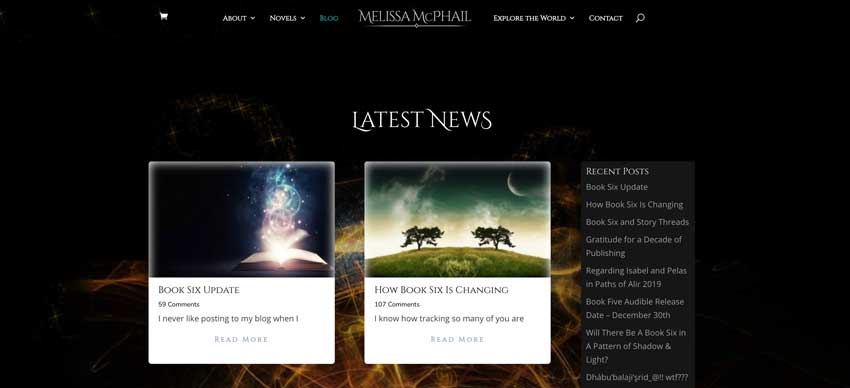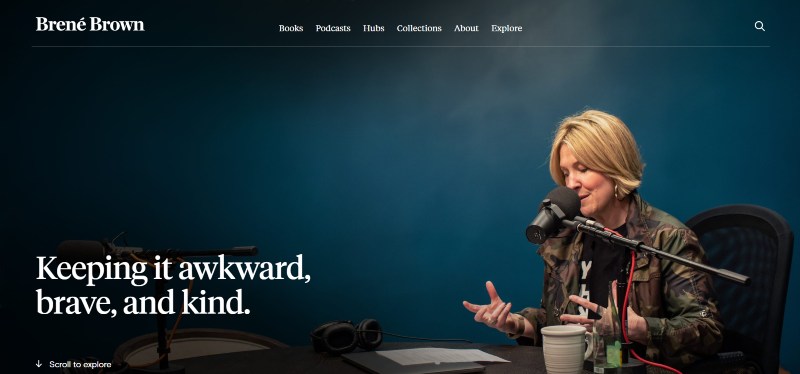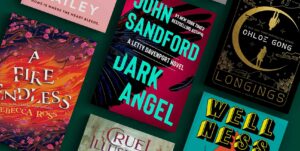Author Branding (How to Get Known and Build A Following)

Author marketing can be confusing and even intimidating. After all this time writing in solitude, you suddenly have to make a real connection with readers to give your work a chance at being read.
Spending time working on your brand as an author is worth doing earlier rather than later. It helps you stand out and come across as someone worth reading.
What is an Author Brand?
An author brand is the overall, lasting impression readers have of you as an author.
It’s the association people make when they hear your name, read the title of one of your books, see your distinctive cover art style (and recognize it as yours), or even see the bright-colored frames on your bald head (if you’re Seth Godin for example) and know exactly who you are!
Love him or hate him, this quote from Amazon’s founder sums it up beautifully:
“Your brand is what other people say about you when you’re not in the room.”
Jeff Bezos
Notice that this isn’t the same thing as who you want to be or what you want people to think you are.
Your author brand includes how others perceive what you stand for, how you present yourself, and the morals and values you have as a person. It can even include the things that you’re strongly against.
Many people wrongly think that branding is only a logo or colors. Yes, these may be brand elements, but a brand is made up of so much more.
Your author brand should show people why they should read your book instead of anyone else’s.
As an author, your branding needs to prove that you’re the perfect person, within your genre, to solve your reader’s challenges. Obviously, these challenges would be different depending on your genre.
You may be writing to
- entertain,
- to inspire,
- to educate,
- or for other reasons.
Each of these purposes as a writer would probably mean a different brand to help your audience understand what you’re about more clearly.
Why you need an author brand
Whether you realize it or not, you already have “a brand” because your brand just means everything people perceive you as. It’s every color choice and font you use, your entire personality, and the way you make others feel about you through your writing.
That’s why it is wise for an author to take control of their brand as it allows you to decide what people think about you as an author before they come to their own conclusions.
The advantage you have as an author who is fully in control of their brand is that you can attract your ideal audience and be able to get them to form a deeper connection with you and your writing.
You can let your brand evolve naturally, but we suggest at least putting some effort into your author brand if you want better marketing results.
Common author branding mistakes

Some common author branding mistakes we see are:
- Creating a brand for “everyone”
- Not knowing your target audience
- Generic branding
- Changing genres too often
1. Creating a brand for “everyone”
Something new authors tend to do is promote their books as “for everyone”.
They want to be inclusive and like to think that this will sell them more books. The truth is, it won’t.
All that happens when you create something “for everyone” is that you lose focus on who your actual audience is and what might appeal to them.
The general rule in marketing is that if you’re speaking to everyone you’re actually speaking to no one. People respond to messages addressed specifically to them, not to “the world.” Figure out who you’re really writing for first, and then you can work out what kind of voice that audience loves to hear.
People often get this confused with “being inauthentic”.
Let’s explain this with an example…
Imagine you’re trying to sell ice cream to kids but you use six-syllable words and list all of your 36 ingredients and the health risks in eating ice cream. It’s your voice, you have a great vocabulary, and it’s important for people to know these health facts about ice cream, right?!
But… do you think this is going to make your audience (kids) want to buy more ice cream?
Of course not!
When you look at this simple example you can see that you probably want to say something like “Comes in 10 fun flavors from Chocolate Ripple Dream to Mint Crackle Surprise. Only costs $3 a cone. Try 3 flavors for free.”
We’ve seen this exact same problem with so many artists and authors. They write for themselves, not their audience. And then wonder why their work never really gains an audience.
Find your own unique voice, yes, but you have a duty to your audience to speak in a way that makes it easy for them to listen.
2. Not knowing your target audience

This goes hand in hand with wanting to write for “everyone”. The issue with not knowing your target audience is that you won’t know who you’re writing to and therefore it won’t truly appeal to anyone and you ultimately would land up with an unappealing brand.
3. Generic branding
Generic branding is author branding that looks like just another “insert your genre” author.
A lot of authors allow their genre to take over their brand and end up as another book on the shelf or online catalog that doesn’t go noticed.
If you take JK Rowling, for example, a very well-known author brand… She writes fantasy, but you’d hardly even think of her work as fantasy. It’s a style of Young Adult, Portal Fantasy that is distinctly her own.
4. Changing genres too often
Each time you change genre you appeal to new readers, this is bad for brand building as you have to then reintroduce yourself and your brand to a new group of people.
This sets your brand building back five steps.
Your brand will never grow or gain trust if you keep changing it.
There is nothing wrong with moving into new genres and new subject matter. Just realize that it’s going to take more work to establish a new audience each time, than if you kept building up a body of work in one genre.
Before you jump genres or subject matter or series, make sure you’ve made enough of an investment in terms of marketing, published work, and audience building in the one you started with.
Changing sub-genres, however, can be a great way to expand your audience, while still keeping active readers. For example, if you write cowboy romance, there’s a good chance your readers will also read your mafia romance.
How do I brand myself as an author?
Here are the steps to follow as an author to build a great brand and entice engagement with your target audience.

1. Define your target audience
The first thing you need to do is define your target audience.
You need to know who you are speaking to and what you are saying.
Once you have defined your audience and you know more about them you’ll be able to speak to them in a way they relate to.
Take the time to dig in and find out about your ideal readers. What are they interested in? Are they mostly moms, high-powered executives, or both? Do they take the bus? Do they read ebooks, and paperbacks, or prefer to listen to audiobooks?
It may sound silly but finding out the answers to these kinds of questions will go a long way to helping you understand how to connect with your audience more closely.
The way to find out is simply to ask them. You can do this using social media or your email list. If you haven’t built up an audience yet you can use tools like SparkToro to find out more about your readers.
2. Define your content and style guide (sometimes called a brand bible)
A style and content guide is important in creating an author brand as it allows for consistency throughout all platforms.
Make sure your author brand has consistency in every aspect, whether it be in your posts or colors. People like consistency. It helps them quickly understand that it’s your content they are reading or viewing.
Style Guide
A style guide can help you to keep things consistent throughout all platforms and all aspects of your brand.
This is simply a short guide on:
- what fonts you use for headings and body text,
- what colors you use,
- your logo and any variations of it,
- and any other type of style or design aspects that are important to you that will repeat in your content and across your channels.
Create a Dropbox or Google Drive folder with the files you need for this guide and a simple document that says how to use them. That way you can easily share it with anyone who helps you with your marketing, or quickly find it yourself when you need to.
Content Guide
When it comes to what you talk about, you don’t have to completely restrict yourself to only talking about a few things, but it does help to focus mainly on 3 central content themes (sometimes called content pillars).
Keeping your style and content on theme means your audience comes to know what to expect from you and is likely to stay with you for longer.
For example, imagine someone subscribes to your newsletter because they love a certain post… Then the next post you publish is completely different and looks completely different. In their mind, this just isn’t what they signed up for so they’re going to be much more likely to unsubscribe.
Author Content Theme Examples:

Epic fantasy author Melissa McPhail’s wildly popular author blog focuses mainly on:
- fantasy writing and publishing,
- the background to her writing processes,
- and updates for her fans on work in progress.
Mike Michalowicz

In contrast, Mike Michalowicz’s business blog focuses on
- marketing,
- cash-flow management,
- and general advice for business owners and entrepreneurs.
Mike is a business author. You can see how different these content themes can be depending on how you’ve defined your author brand.
Just like we covered earlier you can see how each of these authors isn’t trying to be everything to everyone. They’ve dialed down who they’re trying to talk to, and are creating content specifically for that audience, in a way that their audience enjoys receiving it.
3. Project this brand everywhere (social media, website, email, press, etc.)
Once you have established your author brand (style, content themes, and target audience) it’s time to put it out there.
There are many ways to project your author brand. Some effective approaches are through social media, your website, and building an email list. You’ve probably heard this before, but your list will be your number one asset in growing an audience.
Your author website is another asset you’ll need to build your list fast. This is a space where you fully control what is said about you, how it is said, and exactly what you want visitors to do when they’re on your site – hint: it should be to join your list!
I’d also recommend doing what is often referred to as a blog tour. This is where you guest post on other popular blogs in your niche. You can link back to your website of course. This is a free way to get exposure and build your audience.
Blog tours are generally thought of as taking place over a set period, but it helps to always be on the lookout for exposure. This doesn’t just have to be only on other blogs. It can be on podcasts, radio interviews, or even television.
Once you get one or two better-known opportunities it gets easier and easier to get more. You can pitch yourself as being featured on… “insert well-known website or media channel” and you’re much more likely to get a response.
Be sure to always let your audience know what to do in your guest posts or guest interviews. Tell them where to go to buy your book or join your list.
Your content should always have a call to action.
4. A compelling author bio
Your “about the author” page is a central part of your author branding.
This is where you can tell the audience who you are, what inspires you, and what makes you a great source of the kind of content they’re looking for.
It allows the reader to get into your head and figure out who you are. Be sure to check out our guide on writing the perfect “about the author” page (includes examples).
5. Understand “the competition”
We don’t like to call other authors “the competition”. People can read more than one book after all.
But readers can’t read every other book out there, so it still helps to know who you need to be better than.
To beat your competition, you have to understand them, and see what they do right and what they do wrong.
This will change according to your goals.
If you want to find other authors with a very engaged readership, look for very active blogs with lots of comments, or Facebook fan groups with very active communities. If you want high book sales, look at where other authors fall in bestseller lists for their genres.
Try to replicate what they do right in your own, unique way and learn from their mistakes so that you can avoid making the same ones. For example, see what kind of blog posts get more engagement, or which book cover designs and book blurbs seem to be selling their books like crazy.
A little bit of research can go a long way toward giving yourself a head start on other authors who never took the time to learn the playing field.
Author branding examples
There are a lot of authors who get their author branding right.
Brené Brown

- Brené Brown for example does a stunning job of branding herself.
Throughout all of her social media, she remains consistent. Her website is easy to follow and understand and she makes it clear who she is and what her books are about. Notice that even though she uses different fonts and colors above, they still carry a theme of daring and overcoming inner challenges.
J. K. Rowling

- Another author branding example is JK Rowling.
She has spent years ironing out her author brand and has done a great job, whether it be the consistency she shows throughout her book cover art, website, and social media.
She picked a genre she succeeded in and she stuck with it because she knew and understood her target audience.
Stephen King

- Stephan King is a great author branding example.
He found his niche in the thriller genre and knew exactly who he was appealing to. He built his brand around the genre and showed consistency throughout his books and all of his platforms.
He knows all the right fonts, photos, and artwork to use to appeal to his audience while still sticking to his brand.
Eric Carle

- Eric Carle has branded himself as a children’s author spectacularly.
His author brand is based on his most successful story “The very hungry caterpillar”
This is a great tactic because it’s allowed him to focus on his brand and allow people to have something to recognize him by.
His consistency throughout all of his platforms and in his branding is unmatched. His website has amazing scattered paintings of different animals that he also features on all of his other social media.
He knew what appealed to his target audience and he managed to brand himself very well within that genre.
Jack Ketchum

- The final example I’ll mention on great author branding is Jack Ketchum.
What Jack did in terms of his author branding is very clever: he branded himself as “The Scariest guy in America”, and then got another well-known horror author, Stephan King, to reinforce his brand even more.
By doing this he has made his brand even more clear and concise and given himself a name within his genre. What horror wouldn’t want to read a novel by “the scariest guy in America”?
We’re here to help your author brand shine online.
Now that you know all about how to brand yourself as an author you’re probably thinking about where to start!
There are a ton of great author marketing services available online. We specialize in website design services for authors that make your author brand shine more brightly.
Also, be sure to download our free guide on creating a Fan-Focused Author Website and get free help with your author marketing.

Want help with your author marketing? Get our FREE ebook and cheat sheet: 6 Steps To Getting More Readers.
By subscribing, you agree to get emails from me, Matt Ziranek. I’ll respect your privacy and you can unsubscribe any time.






